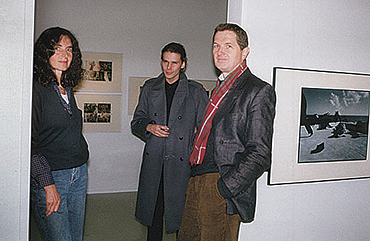
PHOTOGRAPHY 93 TAMPERE
The forgotten Middle Europe returns in Cibulka's photocycles and Klein's performances
The dominance of Anglo-Saxon photography was shaken at Photography 93 Tampere, when Middle-European photography was brought to Tampere. The photographers invited by Photography Centre Nykyaika's Ulrich Haas-Pursiainen, Heinz Cibulka from Austria and Jaschi Klein from Germany, presented photography that was then only known very little in Finland.

The works of Cibulka and Klein have been shown in the German-language Camera Austria, which is as an influential and high-quality a publication as is the late British Creative camera and the American Aperture. Heinz Cibulka made a career already in the 70's as a performance artist and a Viennese actionist. Actionists painted in animal blood in performances that Cibulka documented. He investigated the Catholic culture in his photographs. Cibulka's method was to build photocycles of four photgraphs. (Cibulka 1993). He places pictures of slaughtered animals side by side with family photos and religious images. The comparisons are shocking.
Jaschi Klein's photographs do not impress by their shock value but their poetic quality. Klein staged surrealistic visions in his pictures. He first used people as his models and then animals. Klein's photographs of winged horses are mystical and dream-like. How does a white horse make a black shadow? asks Juhani Niiranen, who attended Klein's workshop, in the magazine Valokuva (Finnish Photography) in 1993. Klein answers: "A philosophical question. I want to simplify, to abstract. By abstracting one can make more of reality." (Niiranen 1993.)
Jaschi Klein can be seen as the representative of the subjective school launched by the German Otto Steinert in the 50's. (Eskildsen etc. 1984.) The NAMNAM-seminar that examined Oliviero Toscani's Benetton-photographs completed the concept of European photography. The seminar of Photography 93 called Morality and sacredness appraised the blurring of the boundaries of advertisements, films and documentary. The genres get mixed up and the audience is confused, or is it? Besides advertisements, the magazine COLORS has been developed as a showcase for Toscani's documentary photos. In the magazine the photographs of different artists and agencies are assembled into theme issues about large and topical subjects, like religion, aids and urban life. The pictures do not really form traditional photo-essays; they illustrate global phenomena as picture galleries. (Vanhanen 2002.)